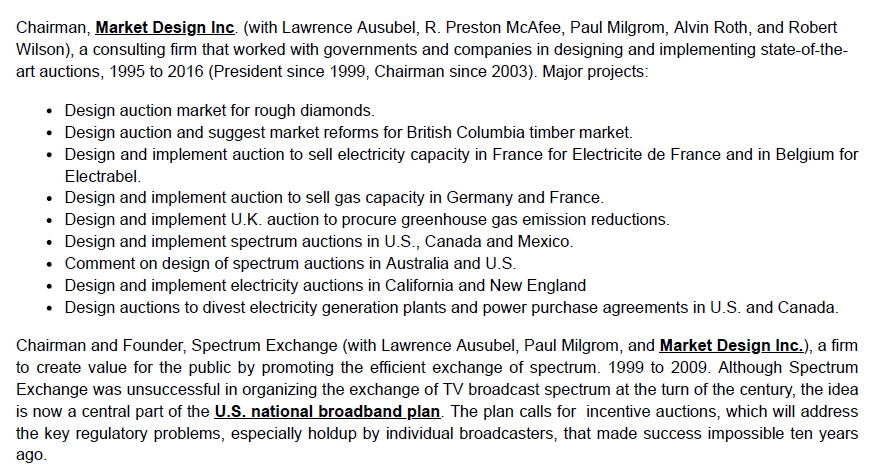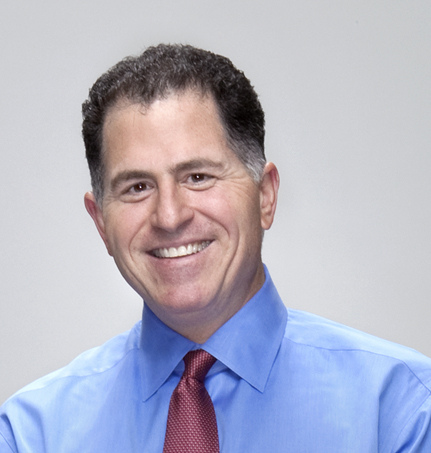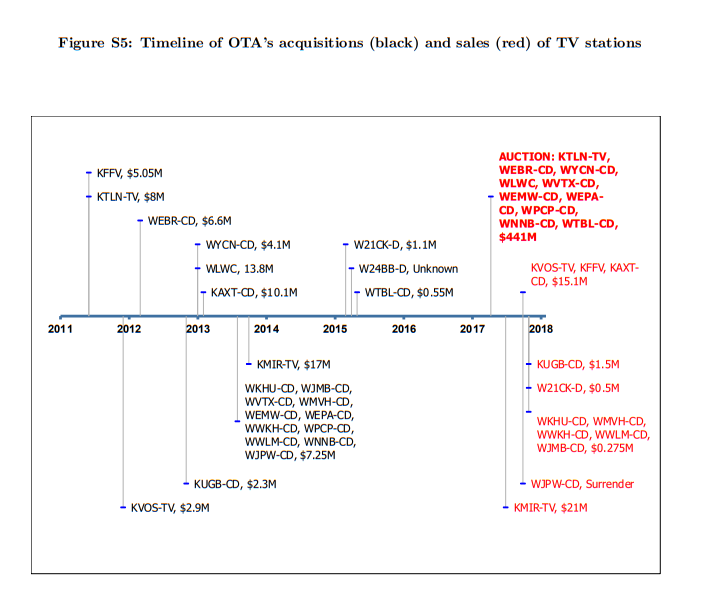Private equity funds such as Michael Dell’s MSD Capital made hundreds of millions of dollars in profits from the 2017 FCC spectrum auction, thanks to the advice of University of Maryland Professor Peter Cramton’s consultancy firm. The auction was designed and implemented by companies founded by his former co-authors and affiliates Paul Milgrom and Lawrence Ausubel, retained as experts by the FCC.
After they get tenure, many academics start a consultancy firm. Very few of them have the opportunity to test their ideas on a $20 billion project, working on both sides of an unprecedented spectrum auction that produced a net benefit of $7 billion for the US Treasury and $10 billion in revenues for a group of broadcasters and private equity firms.
The professional website of University of Maryland professor Peter Cramton is a useful starting point to get a sense of the complex network of academic co-authorships and business partnerships in the community of market design economists who worked on the Federal Communications Commission spectrum auction between 2012 and 2017. The auction was a very complex project to buy back spectrum from television broadcasters in order to reallocate it to mobile companies.

At the end of the auction, mobile companies got the spectrum they needed, but broadcasters also got a $10.05 billion payment to give back the (once public) spectrum they controlled. Years before the auction, four private equity companies had invested in broadcasting companies and now made millions in profits. One of these firms, MSD Capital, was advised by Cramton’s consultancy firm.
MSD Capital also controlled OTA Broadcasting, a company founded by Michael Dell in 2011 with the purpose of participating in the FCC spectrum auction. Between 2011 and 2013, OTA Broadcasting acquired 15 TV stations. As Fortune reported,
“In one instance, Dell’s investment company, MSD Capital, through its subsidiary OTA Broadcasting LLC, acquired a station in Pittsburgh that airs only a local Catholic Church’s daily mass and reruns of the formerly popular TV series ‘Roseanne.'”
The TV stations that Dell and OTA Broadcasting acquired were poor in content, but rich in spectrum.
On February 23, 2012, President Barack Obama signed a bill authorizing the Federal Communications Commission to hold incentive auctions to coax broadcasters to give up their piece of the airwaves. Michael Dell could cash in his investment if the auction rules allowed him to do so.

The FCC retained two different economic consultancies to design and implement the auction: Auctionomics, founded by Paul Milgrom, and Power Auctions, founded by Lawrence Ausubel. Milgrom is a world-famous auction expert and the Shirley and Leonard Ely Professor of Humanities and Sciences in the department of economics at Stanford University and professor by courtesy at the Stanford Graduate School of Business. Ausubel, another well-known auction expert, is a professor in the department of economics at the University of Maryland, with which Cramton is also affiliated.
On Cramton’s website, Milgrom and Ausubel were mentioned as business partners of Cramton in a separate venture, Market Design Inc. (MDI). His website also lists Power Auctions as “an affiliate” of his own consultancy, Cramton Associates:

In a series of tweets and in a ProMarket essay, Glen Weyl—a former academic and current principal researcher at Microsoft—criticized several aspects of the design of the 2017 FCC spectrum auction. The final outcome for taxpayers was disappointing, and private equity firms made profits thanks to the design of the auction and to the help of economists who were colleagues of the auction’s designers, Weyl argued.
This story raises some questions regarding the role of market design economists as discrete advisors “whispering in the ears of princes,” Weyl wrote. His words shocked the academic community because the 2017 auction had widely been considered a triumph of market design and a model for future auctions around the world.
The eternal problem with this kind of auction is that bidders have an incentive to collude at the expense of their counterparts to maximize their return. Therefore, the auction designer’s goal is to make collusion extremely difficult. Auction design is an esoteric sub-field of economics, at the intersection of economics and computer science.
A small number of scholars dominate this recent discipline, probably too small of a number. Between 2012 and 2017, the most respected market designers were all working on both sides of the FCC auction. They were advising clients while also collaborating with each other on academic and business projects.
“All the people involved assured ProMarket that they never spoke to each other about the FCC auction. However, we can map all the connections and confirm the absence of any Chinese Wall between people active on opposite sides.”
All the people involved assured ProMarket that they never spoke to each other about the FCC auction. Peter Cramton declined to comment on the record.
We have no basis to question those statements, not least because there is no way to obtain information on private conversations. However, we can map all the connections and confirm the absence of any Chinese Wall between people active on opposite sides of the auction.

The Market Design Business Network
Paul Milgrom and Peter Cramton have worked together on spectrum auctions for decades. In 1995, Cramton founded MDI with a few of his colleagues to bring innovative auction-related ideas to policymaking. On his website, Cramton lists Milgrom as one of his partners, along with Ausubel, R. Preston McAfee, Robert Wilson, and the Nobel laureate economist Alvin Roth. They had no employees. It was just a team of experts working for governments and corporations on many different projects, from auctions for rough diamonds to greenhouse gas emission reductions.
MDI still existed during the FCC spectrum auctions, even if it was not active.
Cramton, Milgrom, and Ausubel were specifically interested in spectrum auctions: In 1999, they started a parallel company to MDI called Spectrum Exchange. The big idea that Spectrum Exchange wanted to promote was that regulators should give mobile companies the chance to use part of the television broadcast spectrum. Spectrum Exchange’s founders advocated for this approach on many occasions—one of Cramton’s presentations from 2000 is still available online. This “spectrum exchange” is the basic idea that the FCC implemented in 2017.
In the early 2000s, broadcast companies were not interested in selling their portions of the spectrum at reasonable prices. Spectrum Exchange did not succeed—not at that moment, at least. As Cramton explains in his website, “Although Spectrum Exchange was unsuccessful in organizing the exchange of TV broadcast spectrum at the turn of the century, the idea is now a central part of the U.S. national broadband plan. The plan calls for incentive auctions, which will address the key regulatory problems, especially holdup by individual broadcasters, that made success impossible ten years ago.”
Spectrum Exchange lasted 10 years, from 1999 to 2009. In the meantime, its founders each decided to start their own personal ventures.
In 2003, Ausubel founded Power Auctions LLC, a consultancy firm to design and implement innovative auction markets. Power Auctions is a real company, not simply an intellectual venture among economists. In 2018, it had revenues of $490,000.

A few years later, in 2010, Milgrom launched Auctionomics, a consultancy firm with the expertise to both advise auction designers to maximize the revenues of the auctions, and to advise bidders to reach the opposite goal (minimizing the cost of participating in an auction).
Milgrom told ProMarket: “I resigned from Market Design when I founded Auctionomics (long before the incentive auction) to eliminate any conflict between my roles at those two firms.” This information was never included on Cramton’s website.
The Auctionomics website repeatedly mentions the company’s flagship success:
“Our auction consultants have saved billions to clients bidding in high stakes auctions. The Economist reports Paul Milgrom and Jon Levin saving 1.2 billion to a bidder in auction 66. In the 700MHz spectrum auction in Canada, our client paid significantly less than his competitors, close to half compared to one competitor (saving $500m) and only one fifth with respect to another competitor (saving $1.9bn).”
The Auctionomics board of current and former advisors lists, in addition to Alvin Roth, two other Nobel laureates (Kenneth Arrow, who passed away in 2017, and Roger Myerson) and a former FCC chairman.
It took a decade for regulators to endorse the spectrum exchange proposed by Milgrom, Cramton, and their colleagues. Private companies were much quicker to understand how to profit from those ideas.

The Opportunity for Private Equity Companies
Since 2011, Michael Dell has invested many millions in various local TV stations that appear to have no value. Dell is the chairman and CEO of tech behemoth Dell Technologies, but in 1998 he also started a private investment firm that exclusively manages capital for the Dell family: MSD Capital.
According to Business Insider, Dell’s investment in local TV stations was part of a strategy called “spectrum speculation”:
“The investments were likely made in anticipation of the upcoming FCC auction, in which spectrum licenses will be sold to wireless-broadband carriers like AT&T and Verizon, who need additional airwave frequencies to meet the soaring demand for its services.”
Dell was not the only “spectrum speculator.” Other private equity companies controlled by Fortress Investment and Blackstone were buying TV stations just to have some spectrum to sell to the FCC at the incoming auction. But Dell was the only one to retain one of the most respected market designer economists, Peter Cramton, a long term colleague of the two economists that the FCC hired on March 27, 2012, to design the auction according to the Congressional mandate: Paul Milgrom and Ilya Segal of Auctionomics and Lawrence Ausubel of Power Auctions.
According to Power Auctions, the objective of the so-called “incentive auction” was
“to provide a practical market-based mechanism for repurposing some of the US radio communication spectrum below 698 MHz to mobile broadband, which most industry observers believed would be a higher valued use for the spectrum than its existing use for over-the-air television broadcasting.”
The technical challenge for Milgrom and Ausubel was to build two separate auctions that the FCC was supposed to run simultaneously with two opposite goals.
On the one hand, the FCC had to repurchase spectrum from TV broadcasters at the lowest possible price; on the other hand, it had to re-sell it to mobile companies at the highest possible price. If the auctions were not simultaneous, TV broadcasters would hold their spectrum until mobile companies revealed their willingness to pay. Mobile companies would have had incentives to collude in order to minimize costs and state revenues, but with the low prices offered, broadcasters had no incentives to sell. A two-sided blind auction was a possible solution, with the FCC acting as a middleman to preserve competition on both sides of the deal.
One of the problems that Milgrom and Ausubel wanted to minimize was the possibility that TV broadcasters would hold-up relevant quantity of the spectrum in order to reduce supply and maximize profits on the spectrum actually sold during the auction.
Since there are multiple stages in the process, a bidder that owns two stations can decide to drop out of the auction with one station to reduce the quantity offered and maximize the value of the second station. This is a double problem for the auction’s designer: It reduces the amount of spectrum cleared, and it increases the price of the remaining spectrum for mobile companies.
At least two companies adopted this strategy: NRJ TV, a private equity firm that acquired television licenses before the auction; and OTA Broadcasting, advised by Cramton.
As Ausubel and his co-authors wrote in a paper,
“OTA Broadcasting owned 24 stations before the auction. Ten of these stations were sold in the Incentive Auction. It is plausible that OTA Broadcasting employed supply reduction strategies in any of the local markets.”
For example, in the Pittsburgh market, OTA Broadcasting owned eleven stations before the auction but sold only five of those stations. In the San Francisco market, it owned two stations before the auction and sold one of those stations. In the Charlotte market, it owned two stations before the auction and sold one of those stations in the incentive auction.

According to an NBER working paper by Ulrich Doraszelski, Katja Seim, Michael Sinkinson, and Peichun Wang, the quantity reduction strategy increased the payouts for TV broadcasters and private equity firms by 7 percent in the 2017 FCC auction, which is roughly equal to $650 million.
The paper also calculated the profits for OTA Broadcasting, the broadcaster controlled by Michael Dell that Cramton advised during the auction. OTA invested at least $61.6 million in acquiring local TV stations before the auction. That’s a significant sum, but the return on the investment was gigantic: Its revenues from the auction were $441 million, and OTA also sold some TV stations after the auction, bringing its cumulated revenues up to $479.4 million.

The Power of Connections
A technically challenging spectrum auction, celebrated as successful for US taxpayers, happened to also be extremely profitable for private equity firms. It also permitted mobile companies to pay less for the spectrum they needed for smartphone services than it would have if they had dealt separately with each individual broadcaster. It looked like a win-win solution because, in the end, everybody was happy.
However, the TV spectrum was not “owned” by television broadcasters. The spectrum is—or should be—a public good. It is far from obvious whether relocation costs should include billions in profit for private equity firms.
Some economists designed the auction; some helped private equity firms make billions in profit. The troubling aspect is that all those economists were part of the same academic network. They also transformed their academic connections into a business partnership when they moved from pure research to consultancy.
Just to recap: To profit from the FCC auction, Michael Dell retained as consultant an economist, Peter Cramton, who advertises his services on a website where he mentions connections to the economist who designed the auction, Paul Milgrom, and his “affiliation” with the company that had to implement the auction, Lawrence Ausubel’s Power Auctions.
ProMarket asked the FCC three questions: how it chose Milgrom’s Auctionomics and Ausubel’s Power Auctions as its designers, whether it enforced any provisions to prevent conflicts of interest, and whether it investigated the connection between the auction designers and Peter Cramton’s consultancy firm.
The FCC never replied.
Lawrence Ausubel told ProMarket that his company, Power Auctions LLC, and Cramton Associates, Peter Cramton’s advisory that worked with private equity companies,
“are completely independent businesses. I have no ownership interest or role in Cramton Associates. Peter Cramton is not an owner or a principal of Power Auctions LLC. From time to time, Peter has contributed market design expertise to Power Auctions projects, but this has not happened for many years and never for FCC work”.
However, on his website, Cramton mentions Power Auctions as an “affiliate.” ProMarket asked Ausubel how it’s possible that two companies are completely independent but that, at the same time, one is an affiliate of the other. His answer was:
“I suspect that any usage of the term ‘affiliate’ had a different intended meaning than you are attaching to it. It is probably intended to refer to the true fact that Peter and I have done work together from time to time over the years. To repeat, none of this work has been for FCC spectrum auctions.”
Economics literature shows that the mere mention of a connection has an impact on the value and perspective of a company.
In 2001, Boston University professor Ray Fisman found that being connected to Indonesia President Suharto accounted for 23 percent of Indonesian firms’ value on average in the mid-1990s.
In a 2013 paper, Daron Acemoglu and co-authors proved that the announcement of Timothy Geithner as nominee for Treasury Secretary in November 2008 produced a cumulative abnormal return for financial firms with which he had a connection. This return was about 6 percent after the first full day of trading and about 12 percent after ten trading days.
Acemoglu and his co-authors did not find any evidence of any secret deal of explicit favor. However, they concluded, personal connections are even more relevant in extraordinary times such as a financial crisis than they are in a conventional situation. A $20 billion auction might be considered a pretty exceptional situation as well.
As Acemoglu and his co-authors write, “powerful government officials are no different from the rest of us; they know and trust a limited number of people.”
Apparently, market design economists also tend to have a very limited amount of social interactions, given that they seem to only hang out with regulators’ consultants and private equity entrepreneurs.






